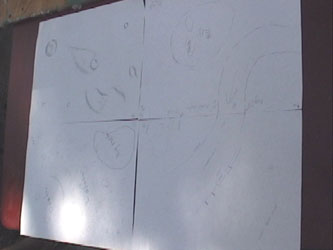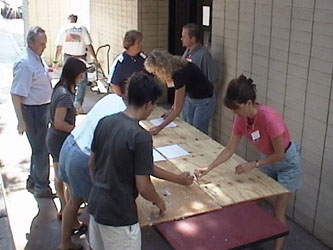

Designing Landscapes
Before creating a landscape, participants view photographs of Mars and determine how they wish to design their portion of the landscape. Participants work in small groups to create a quarter (or eighth) of the complete landscape, which should contain as many of the known features on Mars as possible.
The Mars terrain is varied but the landscapes created for the project must be traversable by the rover. In the real world, no matter how interesting the site may be, engineers will not let scientists send a rover to a landing site that the rover will not be able to navigate. Since the objective of this program is to exchange rovers between participating schools (or classrooms), landscape teams must meet certain constraints to make sure the landscape will not be a hazard for the mission.
Each group creates a pencil sketch of their proposed landscape. This design phase is best done on graph paper or by creating a grid. Communication between the teams is crucial. Groups have to make sure that adjoining sides of the landscape will match when the boards are placed together. If one team wants to have a river wind to the edge of the board, it should be the same height on the neighboring boards. When the boards are connected, all the features must flow from board to board in a continuous landscape.
Steven
Dworetzky gave an overview to his |
 The four teams
sketched out their landscape designs |
 The teams
transferred the landscape sketches onto |
| Home | Contact Us | Credits | Sitemap |
© 2002 - www.imagiverse.org